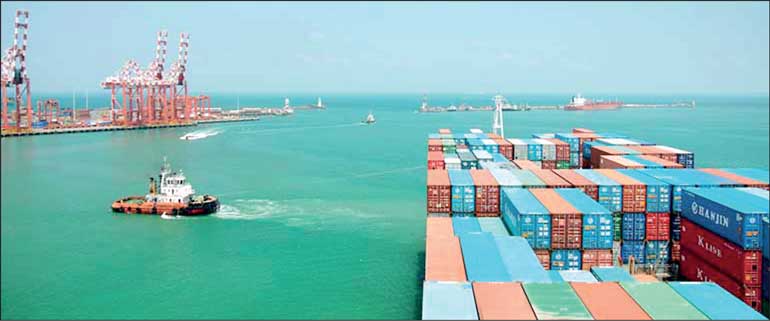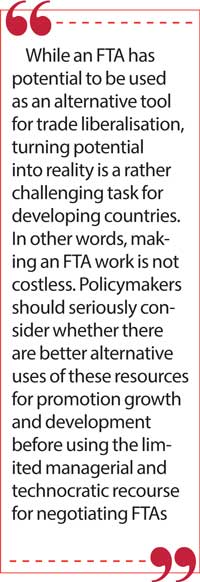Tuesday Dec 09, 2025
Tuesday Dec 09, 2025
Wednesday, 27 December 2023 00:22 - - {{hitsCtrl.values.hits}}

 I have read with much interest the study undertaken by the Institute of Policy Studies in Colombo on the proposed Sri Lanka-Thailand Free Trade Agreement (STFTA): ‘Unveiling trade potential: An ex-ante analysis of the Sri Lanka-Thailand Free Trade Agreement’. The study is very comprehensive and professionally done, and I highly recommend for students and policymakers interested in trade policy.
I have read with much interest the study undertaken by the Institute of Policy Studies in Colombo on the proposed Sri Lanka-Thailand Free Trade Agreement (STFTA): ‘Unveiling trade potential: An ex-ante analysis of the Sri Lanka-Thailand Free Trade Agreement’. The study is very comprehensive and professionally done, and I highly recommend for students and policymakers interested in trade policy.
I personally admire any attempt to strengthen economic ties between our two countries. However, I would like to draw attention to a number of considerations relating to the highly optimistic picture this study has attempted to paint about possible gains from the proposed STFTA. These comments are made with the hope to make the two countries’ efforts to achieve the purpose of strengthening economic ties between them.
The IPS study is based on the assumption that the economic benefits of the STFTA come mainly (if not solely) from the removal or reduction of existing tariffs (P 30). The more the tariff cut, the greater the benefit for both countries. I strongly believe that gains from tariff cuts are overemphasised in this study.
Tariff cuts under FTAs come as an outcome of negotiation between the two countries, unlike in the case of multilateral liberalisation under the World Trade Organization. Tariff cuts may not take place instantaneously as this study has assumed. I have carefully studied tariff concessions offered under a number of FTAs recently signed by Thailand. In all cases, the actual tariff cuts have fallen well short of initial expectations. Domestic protectionist lobby plays an important role in determining the actual outcome of FTAs.
Even when tariff cuts are determined, the actual liberalisation effect would be constrained by the rules of origin (ROOs) (criteria to identify goods eligibility). The projections of these studies have based on the unrealistic assumption that tariff cuts are automatically translated into export/import process, ignoring the ROOs effect. Rules of origins are simply relegated only to a short footnote, presumably because the database of the Global Trade Analysis Project (GTAP) model does not allow for the effects of ROOs. For this reason, the policy makers should treat the reported gains of this study with a pinch of salt.
In an FTA, unlike under multilateral liberalisation under the World Trade Organization or unilateral liberalisation, the participant countries maintain their own external tariffs, which usually differ between member countries, while offering concessional tariffs to the member countries. Thus, it is necessary to combine tariff concessions with ROOs to prevent ‘trade deflection’, that is, transhipment of goods from non-member countries through the member country with the lowest external tariffs to other FTA members. If eligibility criteria imposed for the identification of the true originating of products are stringent and the related administrative mechanism is cumbersome or corrupt, then ROOs can diminish, or even render worthless, the preference margin offered to traders.
There is always a possibility to tweak ROOs or delay the approval process in response to lobby group pressure to undermine the expected trade opening under an FTA. Because of these reasons, how the ROOs are designed and implemented matter a lot for understanding how much market access an FTA really confers. There is evidence from the operation of previous FTAs signed by Thailand that ROOs are often modified in response to the domestic protectionist lobby. Moreover, compliance with ROOS also incurs costs to traders, and they could simply ignore tariff concession offered under an FTA if the cost of compliance the grain from the concession offered.
 The study has ignored the role of global production sharing (GPS), that is, the growing importance of trade in parts and components in place of goods traded in final form within global production networks. Over 60% of manufacturing trade in Thailand takes this form of trade within global production networks. I understand that in recent years GSP trade has been gaining importance in manufacturing trade in Sri Lanka as well. Trade in most electrical and electronic goods trade have become mostly duty-free under the Information Technology Agreement (ITA) of the WTO. Official Customs tariffs are not applicable to trade in these goods, which account for over 40% of trade within global production networks. The simulation analysis of this study has completely overlooked the trade effects of the ITA.
The study has ignored the role of global production sharing (GPS), that is, the growing importance of trade in parts and components in place of goods traded in final form within global production networks. Over 60% of manufacturing trade in Thailand takes this form of trade within global production networks. I understand that in recent years GSP trade has been gaining importance in manufacturing trade in Sri Lanka as well. Trade in most electrical and electronic goods trade have become mostly duty-free under the Information Technology Agreement (ITA) of the WTO. Official Customs tariffs are not applicable to trade in these goods, which account for over 40% of trade within global production networks. The simulation analysis of this study has completely overlooked the trade effects of the ITA.
Even for other goods traded within global production networks, there are many factors, including the nature of the foreign direct investment regime, labour cost, availability of technical manpower, that affect investors’ decision other than tariffs. For example, Victoria’s Secret might not be ready to enter Thai market simply because of tariff cuts: STFTA might not help promoting garment (lingerie) export from Sri Lanka to Thailand.
These reasons explain the limited trade effects of FTAs reported in a number of recent studies. The empirical evidence suggests the limited trade effect of FTAs. (Hayakawa et al. 2016; Jongwanich and Kohpaiboon, 2017; Cadot and Ing, 2019; Jongwanich, 2022). Thailand has signed 14 FTAs with 18 countries (including the multi-county FTA with the Association of Southeast Asian Countries (ASEAN) during 2000 to 2022. As revealed in Jongwanich and Kohpaiboon (2017), preferential export value from Thailand to her FTA partners accounted for less than 50% of total export by 2015. The FTA coverage on the import side has been even lower. On the Thai export side, the FTA varies from a mere 20% of total exports to Thailand and 80% of exports to Australia (Jongwanich and Kohpaiboon, 2017: Figure 2). The Australian share on the export side is because exports of automobiles exported from Thailand accounts for a large share of Thai exports to Australia because of the role of Thailand as an important assembly base for global automobile producers.
Interestingly, products applying to the FTA preferential trade schemes are highly concentrated. For example, among 1,085 items applying for Thailand-Australia FTA in effect since 2006, the top-10 products accounted for 77% of total export from Thailand to Australia (Jongwanich and Kohpaiboon, 2017). The highly concentrated nature of product is also found on the import side. This high concentration at the product level would point to ROOs and regulatory cumbersome in proving product origin that could constrain firms to apply for the scheme. It also indicates it is not easy and costless for firms to alter their sourcing practices just to compile with ROO. Firms make use of tariff preferences offered under FTAs only when their existing sourcing patterns fit to ROO requirement. Otherwise, the scheme will not be use.
The existing sourcing patterns of firms has to be compatible with the trade patterns between two countries, in order for an FTA to be appealing to traders. What is meant by ‘Compatibility of trade’ is the extent to which the trade patterns of a given country match with that of its partner country: whether products exported by a given partner country are the ones mostly imported by the other partner country and vice versa. The degree of trade compatibility depends on a country’s comparative advantage in international production, which in turn depends on the nature of resource endowment and the stage of economic development.
The economic size of the country also matters, because larger countries generally tend to have a more diversified product mix. Most of the FTAs listed in the policy debate as ‘success’ cases (such as the North American Free Trade Agreement [NAFTA], Vietnam-US FTAs and FTAs of Australia and New Zealand with China) are between countries with strong trade compatibility on both import and export sides. Trade compatibility between Thailand and Sri Lanka is yet to be systematically analysed. However, by simply looking at the data on trade patterns between the two countries, I doubt whether there is much compatibility to make a strong case for signing an FTA between the two countries.
In sum, while an FTA has potential to be used as an alternative tool for trade liberalisation, turning potential into reality is a rather challenging task for developing countries. In other words, making an FTA work is not costless. Policymakers should seriously consider whether there are better alternative uses of these resources for promotion growth and development before using the limited managerial and technocratic recourse for negotiating FTAs.
References:
Athukorala P. and A. Kohpaiboon (2011) ‘Australia-Thai Trade: Has the Free Trade Agreement Made a Difference?’, Australian Economic Review, 44(4), 1-11.
Cadot, O. and L. Ing (2019), ‘How restrictive are ASEAN’s Rules of Origin?’ in L. Ing, M. Richardson, and S. Urata (eds.) East Asian Integration: goods, services and investment, Routledge, New York.
Hayakawa, K., N. Laksanapanyakul, and S. Urata, (2016), ‘Measuring the costs of FTA utilization: evidence from transaction-level import data of Thailand, Review of World Economics, 152(3): 559-575.
Jongwanich, J. (2022) The Economic Consequences of Globalization on Thailand, Routledge, Taylor & Francis Group.
Jongwanich, J. and A. Kohpaiboon (2014), Exporter responses to FTA tariff preferences: evidence from Thailand, Asian-Pacific Economic Literature, vol. 31 (1): 21-38.
(The writer is attached to the Faculty of Economics, Thammasat University, and is Head of the International Competitiveness Research Cluster in Thailand.)